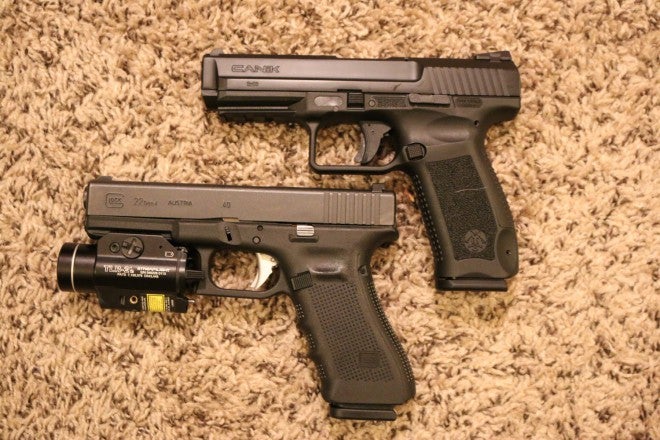Zarvan
ELITE MEMBER

- Joined
- Apr 28, 2011
- Messages
- 54,470
- Reaction score
- 87
- Country
- Location

The frame is black polymer. The front adorned with a three slot Picatinny rail. Texturing is present on the grip sides and where the trigger finger rests on the frame (a nice touch). Additional writing is on the frame with the usual warnings to read the manual, “Made in Turkey”, and a note that it will fire without a magazine present (sad that the note has to exist). The front and rear straps are covered with a large scale type checker texture and the heel of the frame has interesting scallops (which we will cover later). The rear backstrap is held in with a pin that can do double-duty as a lanyard adapter.
Inside the gun, the feed ramp and chamber are highly polished. The slide rides on four metal rails molded into the frame. The slide stop and release are on the left side of the magazine well and the trigger rides on the right, with a drop-safe striker blocker and an interesting rear mechanism which provides for an excellent trigger pull. Speaking of, the trigger has a carrot-style passive safety.
Shooting the Canik TP9 SF
Like most double-stack magazines, the included magazine loading tool is pretty much useless for the last 5 rounds, which is just fine when one owns a LuLa. Loaded up with the full 18 rounds, the magazine slid into position with an affirmative click and racking the slides rear-only serrations, the ubiquitous Winchester White Box bulk pack ammunition went into battery with nary a hitch. The loaded chamber indicator popped up and the strike was at the rear, showing red and ready to fire.

Drawing from the provided holster was familiar, as it is a carbon-copy of the SERPA holsters. I put the holster at a slight forward cant, as I find that more comfortable when wearing the handgun on a high-riding belt. The weapon clears the holster without issue and the paddle kept it firmly in my trousers on stand-by to accept its charge again when its task was completed.

Using the standard backstrap, the gripped filled my medium-sized hands (according to the military, I have 57th percentile hand size) and I found the scallops at the bottom of the grip were indeed useful. With a solid one-hand grip, my heel meets with that heel to allow the handgun to sit farther back and more comfortably into the palm. They look goofy as can be, but in this case form follows a solid function. The checkering on the front and back is quite passive, but stable with dry hands. In fact, my hand felt more of the sandpaper textured sides than the front and rear.
Reaching for the trigger, my finger sat comfortably on the face but was dismayed at the excessively long take-up. At the bottom edge of the trigger on its pivot, it’s nearly a ½”! Persevering through it finds a solid wall (which surprised my finger as this was a stock striker-fired handgun) and at about 5 lbs on the finger-scale (my Lyman digital scale reads it 4.4-4.8 lbs), the shot released. Reset is fast and compared to a Glock, more sound than the tactile, but its close. To get a Glock anywhere near this pull requires trigger parts that cost near as much as the Canik handgun itself. Its out-freaking-standing considering the price.
Recoil was decidedly 9mm and the slide slammed home, dipping the muzzle. The extra weight of the slide plus recoil spring was more than expected but after a few rounds, one learns to take advantage of the momentum to bring the muzzle on target fast without dipping. What was noticed, only slightly, was the higher bore axis which is similar to shooting the P320. The newbie shooter will not feel it, but for someone accustomed to tuned weapons, it will feel slightly heavy. Again, a few rounds and one is used to recoil sensation and it’s nothing that will keep one from going fast on the go-pedal when needed. (Note* Canik has a race-ready long-slide TP9 coming soon and outside of adjusting take-up, I don’t see a need to change the trigger).
18 rounds went through the handgun without issue and with the slide locking back, became what was a boring range session. As a writer and reviewer, I actually hope for a malfunction as it gives us something to write about, but when a gun just goes bang every time with every round fed, there is no prose out there to do it justice other than to say, “It just worked.”
The sights are a three dot affair, which brought up my only real true annoyance with the handgun, the front sight dot is not lined up with the rear dots when the top of the sights are aligned. The front sight is dovetailed in place, held by friction and the rear likewise, but adds a grub screw for additional retention. To help with alignment, the rear sight has a vertical line, which is refreshing as its near impossible to mis-align the front sight in low-light or at night. According to Century, the front and rear sight are from existing designs, but they did not disclose which series the sights were from.
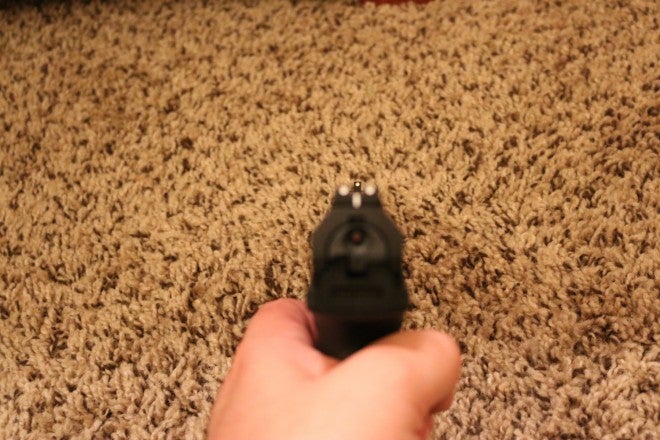
Accuracy was decidedly “good enough” putting up respectable fist to hand-sized groupings at 7 yards banging away on the trigger. Trying to push it out to range (25 yards), the “two-stage” trigger shined, keeping groups within the torso area off-hand. Using a makeshift rest, groups shrunk to soccer-ball sizes, which is the limit of what my eyes can do under searing fluorescent light.
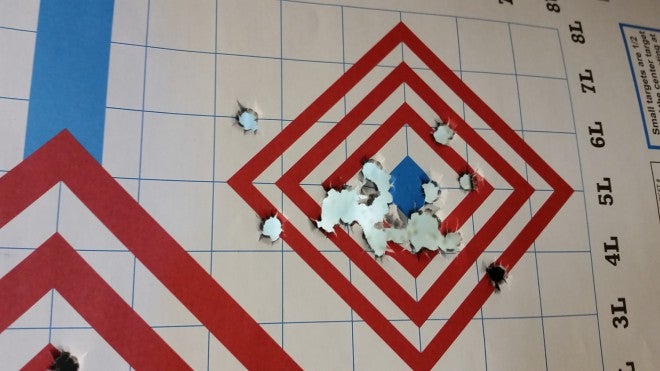
7 yards, standing, off-hand, slow fire
And throughout the session, using Freedom Munitions and Midwest Ammunition (both factory reloads), the handgun just kept chewing away. Upgrading to defense loads (Federal HST and Hornady Critical Defense) saw no decrease in group sizing though an increase in felt recoil with the stouter loads.
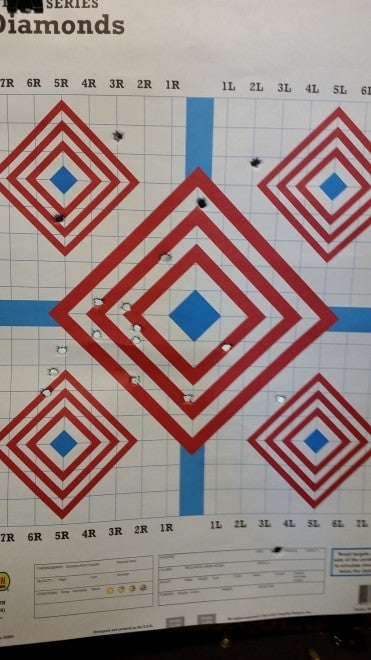
25 yards, standing, slow-fire.
Would I call it a “great shooter”? No, I wouldn’t, but I can’t write and say its a bad shooter. For the accuracy nut, new sights and perhaps a new barrel may be in order, but for the general shooter, its good enough to take to a 3-gun match and not be out-classed by anything save the high-end race guns. As such, I pronounce it “good enough.”
The Good:
- Price (at $350 retail) is almost unbeatable for a semi-automatic standard-capacity handgun. When you add in the quality it’s a veritable bargain.
- Ignoring the ridiculous take-up, the trigger is superb for a striker-fired pistol. Reset is just as good. Once on the trigger, it’s a full-on go-pedal.
- Sights are three-dot affair but the vertical line does keep them sorted and ensures front sight post alignment.
- Monotonously reliable.
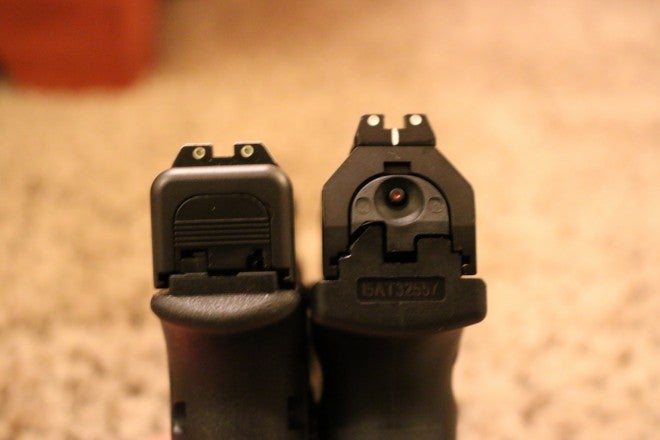

The Notable:
- Arrives with two magazines, but includes a SERPA-style holster.
- Adjustable back straps cover most people, but those with too small or too big hands may find want more adjustability.
- Adds features like cocked striker and loaded chamber indicators.
- Swappable ambidextrous magazine release, but slide release is left-side only.
- Machined match grade barrel with button rifling.
- Sig Sauer height on the bore axis. While controllable (being 9mm), it could be more controllable lower.
- As reported in other reviews, the depth of the picatinny rails is not to spec. They can be filed down, but its annoying when the spec has been around for such a long time.
Final Thoughts:
It’s not often I come away truly impressed with a weapon. Yes, I can find fault with some of the basic pieces on the weapon (the high bore axis and lack of mirrored ambidextrous features), but considering the price of the handgun I am apt to overlook them. Street price for these will be only $300 freaking dollars!
In all the places that Glock set the US market on fire nearly thirty years ago, the Canik TP9 SF has comes and beats it at its own game. The Canik has 18+1 compared to the Glock 17’s 17+1, the trigger is far and above better, its more comfortable, fit and finish is on par, adds features such as the two indicators (striker and loaded chamber), and a price that beats the market soundly. Where the Smith and Wesson M&P and Springfield XD series have become the Glock’s contemporaries, the Canik has the potential to beat them all.*
*I say this as while the handgun functioned well for me over 500+ rounds, the true longevity and reliability of a handgun can only be tested over years. Assuming the Canik meets or beats the Glock on this respect too, I’d be hard-pressed to recommend anything but this for the basic handgun buyer.
For now, I’d recommend both on the basis of price/performance vs. the rugged reputation/aftermarket. Still, it’s only a matter of time until the Canik’s TP9 SF’s reputation and aftermarket is sorted. Until then, it’s worth giving it a shot.
UPDATE: The barrels are button rifled.

